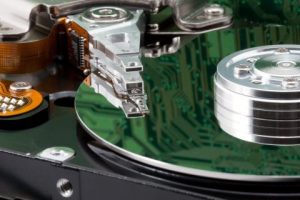 If your hard drive seems to “spin up,” but your computer can’t recognize it, you’ve got a problem — but in many cases, the solution is fairly straightforward (the quickest and most likely solution is to check your data connections).
If your hard drive seems to “spin up,” but your computer can’t recognize it, you’ve got a problem — but in many cases, the solution is fairly straightforward (the quickest and most likely solution is to check your data connections).
In this article, we’ll guide you through some basic steps for diagnosing and troubleshooting the issue. First, an important caveat: If your hard drive holds important data and your computer cannot detect it, you should keep it powered off. Operating a damaged hard drive can cause permanent data loss, and generally, you’ll only get one chance to recover your data. Contact a professional data recovery provider as soon as possible.
Datarecovery.com provides risk-free evaluations for all hard drives, and we support our services with a no data, no charge guarantee: If we’re not able to recover the files you need, there’s no charge for the attempt. To learn more, schedule a free evaluation online or call 1-800-237-4200.
With that in mind, here’s how to troubleshoot a “hard drive spins but is not detected” failure scenario.
“Hard Drive Spinning But Not Detected:” Common Causes
The most common causes for “hard drive not detected” errors include:
- Faulty data cable connections. This is the most frequent issue, so it’s the first thing to check: Your hard drive may be receiving power, but its SATA connection (or IDE connection, for older hard drives) may be loose.
- Bad SATA/IDE cables. If your drive has a good connection, the cable itself may be faulty.
- A bad SATA/IDE port. Switching to another SATA/IDE port may resolve the issue.
- Missing or corrupt partitions. Without partitions, the operating system may fail to recognize the drive as a storage device. Read about lost hard drive partitions.
- BIOS boot settings. Your BIOS may fail to recognize your hard drive as a boot device, particularly if you’re working with a brand-new motherboard or a brand-new HDD. Check the BIOS settings to make sure that your hard drive is identified as a boot device.
- Failed hard drive components. The hard drive may seem like it’s operating normally, but if the read/write heads aren’t able to locate track zero (the first 64 sectors of the disk, where essential bootstrap code is written), the hard drive will not function. It may appear as nonexistent to the operating system, though the BIOS will usually identify the hard drive.
- Corrupt or outdated drivers (for external hard drives). Drivers allow a computer to interface with storage media and other devices.
Again, if your hard drive fails to recognize and you need data from the device, we strongly recommend seeking assistance from a data recovery provider. You should not run data recovery software; data recovery software cannot fix physical or electronic hard drive issues.
“Hard Drive Not Detected” Troubleshooting Steps
If your hard drive has damaged components, there’s not much you can do (other than seek help from a data recovery provider). However, as we’ve discussed, most hard drive detection issues are caused by faulty connections.
Follow these steps:
- Check all connections, particularly data connections. Do not force data cables into place.
- Try another data cable (SATA/IDE/etc.) and another data port on your motherboard. For external hard drives, try another USB cable; if the hard drive is powered via USB, make sure your USB port provides enough power for the storage device.
- Try connecting the drive to another computer.
- If the drive is new (and contains no data), make sure it’s formatted in a supported file system. Learn how to reformat and repartition a hard drive in Windows and how to repartition with Mac OS’s Disk Utility.
- If the drive is an external hard drive, make sure you’re using the latest drivers.
When a hard drive spins but isn’t detected, the prognosis for data recovery is fairly good. The best practice is to stop operating the drive; otherwise, the device could sustain significant data corruption or permanent physical damage.
Datarecovery.com provides free media evaluations, and each of our locations features fully equipped onsite laboratories with cleanrooms, firmware repair tools, and proprietary data recovery technologies. Get started by scheduling a case online or call 1-800-237-4200 to speak with a member of our team.




